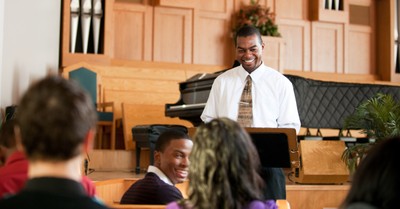Three Steps for Studying the Gospels
- Johnny Cisneros Bible Study Magazine
- Updated Mar 06, 2012

Bible Study Guide for the Gospels
3 STEPS
1. When reading biblical stories, consider: theme, fit, characters, location, time and the events.
2. Consult the Bible, a theology book, Bible dictionaries and commentaries.
3. Summarize the passage in light of what you’ve learned.
John 4:4 (NIV)
4 Now he had to go through Samaria. 5 So he came to a town in Samaria called Sychar, near the plot of ground Jacob had given to his son Joseph. 6 Jacob’s well was there, and Jesus, tired as he was from the journey, sat down by the well. It was about noon.
7When a Samaritan woman came to draw water, Jesus said to her, “Will you give me a drink?” 8 (His disciples had gone into the town to buy food.)
9 The Samaritan woman said to him, “You are a Jew and I am a Samaritan woman. How can you ask me for a drink?” (For Jews do not associate with Samaritans.) 10 Jesus answered her, “If you knew the gift of God and who it is that asks you for a drink, you would have asked him and he would have given you living water.”
11 “Sir,” the woman said, “you have nothing to draw with and the well is deep. Where can you get this living water? 12 Are you greater than our father Jacob, who gave us the well and drank from it himself, as did also his sons and his flocks and herds?”
13 Jesus answered, “Everyone who drinks this water will be thirsty again, 14 but those who drink the water I give them will never thirst. Indeed, the water I give them will become in them a spring of water welling up to eternal life.”
15 The woman said to him, “Sir, give me this water so that I won’t get thirsty and have to keep coming here to draw water.”
16 He told her, “Go, call your husband and come back.”
17 “I have no husband,” she replied. Jesus said to her, “You are right when you say you have no husband. 18 The fact is, you have had five husbands, and the man you now have is not your husband. What you have just said is quite true.”
19 “Sir,” the woman said, “I can see that you are a prophet. 20 Our ancestors worshiped on this mountain, but you Jews claim that the place where we must worship is in Jerusalem.”
21 “Woman,” Jesus replied, “believe me, a time is coming when you will worship the Father neither on this mountain nor in Jerusalem. 22 You Samaritans worship what you do not know; we worship what we do know, for salvation is from the Jews. 23 Yet a time is coming and has now come when the true worshipers will worship the Father in the Spirit and in truth, for they are the kind of worshipers the Father seeks. 24 God is spirit, and his worshipers must worship in the Spirit and in truth.”
25 The woman said, “I know that Messiah” (called Christ) “is coming. When he comes, he will explain everything to us.” 26 Then Jesus declared, “I, the one speaking to you — I am he.”
FIT
Question: Where does the passage ‘fit’ in the book? What happens before the story and what happens after?
Answer: Before? Jesus’ conversation with Nicodemus, a Jewish religious leader (31–21), contrasts ironically with His conversation with a Samaritan woman (4:4–26). Nicodemus, a learned man, was baffled by Jesus’ words (3:9), but the untrained Samaritan woman recognizes Jesus as prophet and Messiah (4:19, 29). After? Because of the woman’s testimony, other Samaritans believe (4:42; compare 1:11).
THEME
Question: What is the major theme of the book?
Answer: “Jesus as the Messiah and Son of God who came into the world to bear witness to the truth and to give his life so that all people might have the opportunity of receiving eternal life through faith in him.” (Marshall, New Testament Theology)
CHARACTERS
Question: What characters are involved?
Answer: Crowds? None. Individuals?
1. Jesus (4:4)
2. A Samaritan woman (4:7). “The Samaritans were regarded by the Jews as despised half-breeds, the offspring of the resettlement policies of the cruel Assyrians. ... The Jewish desire for a pure and loyal people of God, particularly after the return from the Babylonian exile, led Ezra to develop a segregation policy that excluded Samaritans and others of mixed backgrounds (Ezra 9–10)” (Borchert, John 1–11)
3. Jacob (4:5)
4. Joseph (4:5)
5. Prophet (4:19)
6. God as Father (4:20–21, 23)
7. Samaritans (inferred from 4:22)
8. Jews (4:22)
9. Messiah (4:25). Since Samaritans only viewed the first five books of the Bible as authoritative, “a Messiah from the house of David could not be anticipated, as no evidence for such could be found in the Pentateuch. Rather, the Samaritans awaited a ‘prophet like Moses’ based on Deuteronomy 18:15–18.” (Tyndale Bible Dictionary)
LOCATION
Question: Where does the story take place?
Answer: Location? A well (4:6) City? Sychar (4:5) Region? Through Samaria (4:4). “This was the shortest route from Judea to Galilee but not the only way. … In Jesus’ day the Jews … normally took the eastern route in order to avoid Samaria. But Jesus chose the route through Samaria in order to reach the despised people of that region” (Bible Knowledge Commentary, 284). Other locations? Jerusalem and “this mountain” (4:20–21). “Gerizim remains the sacred mount of the Samaritans’ for they have ‘worshiped on this mountain’ [Jn. 4:20] for countless generations, ascending it to [keep] the feasts of Passover, Pentecost and Tabernacles. According to Samaritan tradition, Gerizim is Mt Moriah [Gn. 22:2] and the place where God chose to place his name [Dt. 12:5]” (New Bible Dictionary, 406).
EVENTS
Question: What happens in the story?
Answer: Is it a teaching (e.g., a parable or instruction)? No.
What is the sequence of events?
1. Jesus shows care and concern for a Samaritan woman in spite of her ethnicity, gender, and sin.
2. Jesus corrects the Samaritan woman’s view of God and worship.
3. Jesus confirms to her that He is the Messiah.
TIME
Question: Where does the story take place?
Answer: “The sixth hour [4:6] would be noon, the hottest part of the day. It was unusual for a woman to visit the well alone.” (New Bible Commentary) Yet this Samaritan woman does exactly that, perhaps because her reputation (4:18) had made her a social outcast. How much time has passed? Same day. Described by a proper name (e.g., Passover, Sabbath, Feast of Tabernacles)? No.
SUMMARY
Question: How would you summarize the purpose of this story?
Answer: This passage teaches us about Jesus, the Living God.
God exposes the contents of our hearts, not for our shame, but for our good.
Jesus communicated care before He communicated content.
Jesus worked with what the woman already knew. He didn’t argue about what books were included in her Bible, but He was not hesitant to correct her view of God.
Jesus wasn’t concerned with the popular customs of Jewish piety, but he was concerned for a person.
We can trust that God, who knows our hearts, is able and willing to help us even in the midst of our shame.
As we make disciples, we must communicate care and concern along with content.
As we make disciples, we must discern what points in a person’s worldview can be used as a bridge to a biblical worldview. This requires that we be bold yet respectful.
Holiness is not about preserving traditions, but about preserving people.
Resources Used
I. Howard Marshall, New Testament Theology: Many Witnesses, One Gospel (Downer Grove: InterVarsity Press, 2004), pg. 512. Logos.com/Marshall
Gerald L. Borchert, John 1–11 (New American Commentary Vol. 25a; Nashville: Broadman and Holman, 1996), pgs. 199–200. Logos.com/NAC
Walter A. Elwell and Phillip W. Comfort (eds.), Tyndale Bible Dictionary (Wheaton: Tyndale, 2001), pg. 1154. Logos.com/TBD
John F. Walvoord and Roy B. Zuck (eds.), The Bible Knowledge Commentary (Vol. 2; Dallas: Victor, 1983–1985), pg. 284. Logos.com/BKC
D.R.W. Wood and I. H. Marshall (eds.), New Bible Dictionary (3rd ed.; Downer Grove: InterVarsity Press, 1996), pg. 406. Logos.com/NBD
D.A. Carson, R. T. France, J. A. Motyer and G. J. Wenham (eds.), The New Bible Commentary (Downer Grove: InterVarsity Press, 1994), pgs. 1033–34. Logos.com/NBC
Article courtesy of bible study magazinepublished by logos bible software. Each issue of Bible Study Magazine provides tools and methods for Bible study as well as insights from people like John Piper, Beth Moore, Mark Driscoll, Kay Arthur, Randy Alcorn, John MacArthur, Barry Black, and more. More information is available at http://www.biblestudymagazine.com. Originally published in print: Copyright Bible Study Magazine (Sept–Oct 2009): pgs. 16–17.
Publication date: February 29, 2012





















